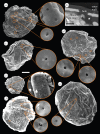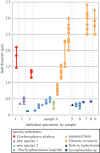Tiny vampires in ancient seas: evidence for predation via perforation in fossils from the 780-740 million-year-old Chuar Group, Grand Canyon, USA
- PMID: 27194696
- PMCID: PMC4892792
- DOI: 10.1098/rspb.2016.0221
Tiny vampires in ancient seas: evidence for predation via perforation in fossils from the 780-740 million-year-old Chuar Group, Grand Canyon, USA
Abstract
One explanation for the Early Neoproterozoic expansion of eukaryotes is the appearance of eukaryovorous predators-i.e. protists that preyed on other protists. Evidence for eukaryovory at this time, however, is indirect, based on inferences from character state reconstructions and molecular clocks, and on the presence of possible defensive structures in some protistan fossils. Here I describe 0.1-3.4 µm circular holes in seven species of organic-walled microfossils from the 780-740 million-year-old Chuar Group, Grand Canyon, Arizona, USA, that are similar to those formed today by predatory protists that perforate the walls of their prey to consume the contents inside. Although best known in the vampyrellid amoebae, this 'vampire-like' behaviour is widespread among eukaryotes, making it difficult to infer confidently the identity of the predator. Nonetheless, the identity of the prey is clear: some-and perhaps all-of the fossils are eukaryotes. These holes thus provide the oldest direct evidence for predation on eukaryotes. Larger circular and half-moon-shaped holes in vase-shaped microfossils from the upper part of the unit may also be the work of 'tiny vampires', suggesting a diversity of eukaryovorous predators lived in the ancient Chuar sea.
Keywords: Neoproterozoic; Precambrian palaeontology; Vampyrellida; acritarch; drill holes.
© 2016 The Author(s).
Figures





Similar articles
-
Chuar Group of the Grand Canyon: record of breakup of Rodinia, associated change in the global carbon cycle, and ecosystem expansion by 740 Ma.Geology. 2000 Jul;28(7):619-22. doi: 10.1130/0091-7613(2000)28<619:cgotgc>2.0.co;2. Geology. 2000. PMID: 11543503
-
Phosphatic scales in vase-shaped microfossil assemblages from Death Valley, Grand Canyon, Tasmania, and Svalbard.Geobiology. 2021 Jul;19(4):364-375. doi: 10.1111/gbi.12439. Epub 2021 Feb 25. Geobiology. 2021. PMID: 33634584
-
Organic preservation of vase-shaped microfossils from the late Tonian Chuar Group, Grand Canyon, Arizona, USA.Geobiology. 2023 May;21(3):290-309. doi: 10.1111/gbi.12544. Epub 2023 Jan 18. Geobiology. 2023. PMID: 36651474
-
Precambrian biota: protistan origin of trace fossils?Curr Biol. 2009 Jan 13;19(1):R28-30. doi: 10.1016/j.cub.2008.11.003. Curr Biol. 2009. PMID: 19138588 Review.
-
The evolution and distribution of life in the Precambrian eon-global perspective and the Indian record.J Biosci. 2009 Nov;34(5):765-76. doi: 10.1007/s12038-009-0065-8. J Biosci. 2009. PMID: 20009270 Review.
Cited by
-
Proterozoic microfossils continue to provide new insights into the rise of complex eukaryotic life.R Soc Open Sci. 2024 Aug 21;11(7):240154. doi: 10.1098/rsos.240154. eCollection 2024 Aug. R Soc Open Sci. 2024. PMID: 39170929 Free PMC article. Review.
-
Amoebozoan testate amoebae illuminate the diversity of heterotrophs and the complexity of ecosystems throughout geological time.Proc Natl Acad Sci U S A. 2024 Jul 23;121(30):e2319628121. doi: 10.1073/pnas.2319628121. Epub 2024 Jul 16. Proc Natl Acad Sci U S A. 2024. PMID: 39012821
-
Tubule system of earliest shells as a defense against increasing microbial attacks.iScience. 2024 Feb 6;27(3):109112. doi: 10.1016/j.isci.2024.109112. eCollection 2024 Mar 15. iScience. 2024. PMID: 38380247 Free PMC article.
-
Testate amoebae (Arcellinida, Amoebozoa) community diversity in New England bogs and fens assessed through lineage-specific amplicon sequencing.Eur J Protistol. 2024 Feb;92:126049. doi: 10.1016/j.ejop.2023.126049. Epub 2023 Dec 15. Eur J Protistol. 2024. PMID: 38163403
-
Strong evidence for a weakly oxygenated ocean-atmosphere system during the Proterozoic.Proc Natl Acad Sci U S A. 2022 Feb 8;119(6):e2116101119. doi: 10.1073/pnas.2116101119. Proc Natl Acad Sci U S A. 2022. PMID: 35101984 Free PMC article.
References
-
- Paine RT. 1966. Food web complexity and species diversity. Am. Nat. 100, 65–75. (10.1086/282400) - DOI
-
- Vermeij GJ. 1977. The Mesozoic marine revolution: evidence from snails, predators and grazers. Paleobiology 3, 245–258.
-
- Kelley PH, Kowalewski M, Hansen TA. 2003. Predator-prey interactions in the fossil record. Berlin, Germany: Springer Science & Business Media.
-
- Jurkevitch E. 2007. Predatory behaviors in bacteria: diversity and transitions. Microbe 2, 67.
Publication types
MeSH terms
Associated data
LinkOut - more resources
Full Text Sources
Other Literature Sources


